The Littlewood Treaty, The True English Text of the Treaty of Waitangi, Found
Chapter: Précis 1 2 3 4 5a, 5b, 5c, 5d, 5e 6 7 8 9 10 11 12 13 14 15 16 17 18 19 20 Lord Normanby's Brief Additional Resources
Chapter 14
FOR WANT OF A NAIL
‘For want of a nail the shoe was lost. For want of a shoe the horse was lost. For want of a horse the rider was lost. For want of a rider the battle was lost. For want of a battle the kingdom was lost. And all for the want of a horseshoe nail’ (John Gower’s Confesio Amantis, circa 1390).
One commentator describes this well-known children’s rhyme and the moral lesson contained within it as:
‘A clever set of lyrics encouraging children to apply logical progression to the consequences of their actions. “For want of a nail” is often used to gently chastise a child, whilst explaining the possible events that may follow a thoughtless act’.
A nail comes adrift.
Hobson was quite a sick man from the day he arrived in New Zealand and a very sick man one month later, having been stricken with a debilitating stroke and uncertain if he would ever recover sufficiently to carry on as Lieutenant-Governor. Even on the 5th of February, at the treaty grounds, his pallid and sickly expression did not go unnoticed. After the meeting an old chief confronted Hobson and his party as they made their way to their boat, and gazed intently into the Lieutenant Governor’s face for a few minutes. ‘Then in a loud shrill voice he cried out in wailing tones - “Aue he koroheke! E kore e roa kua mate”. Hobson asked Reverend William Colenso for a translation of what was said, but Colenso was evasive, until pressed by Hobson to tell him. Reluctantly, Colenso told him that the grey haired chief had said - ‘Alas! An old man. He will soon be dead’ (See The Treaty of Waitangi, by T.L. Buick, pg. 148).
Throughout much of the first month in New Zealand, Hobson was running on empty, but pushed himself hard, even though he had few energy reserves to draw upon. Although he always attempted to keep up appearances and exhibit an astute and noble bearing, or put on as brave a face as he could in public, it’s likely he virtually collapsed into bed upon his return, each day, to the seclusion of his cabin aboard H.M.S Herald or other facilities where he stayed. Because of illness, Hobson had to rely heavily on his staff, some of whom he barely knew. One such individual was James Stuart Freeman, a 3rd class clerk assigned to Hobson by Governor Sir George Gipps of N.S.W. to act as Hobson’s private secretary. Of some of the staff assigned to Hobson, a future Auckland newspaper editor, Samuel Martin, wrote:
‘Captain Hobson is accompanied by several officers, selected for their known incompetency, by George Gipps. What assistance he is to expect from these persons I do not know, but they are evidently sent to New Zealand because Sir George Gipps has no use for their services here, and was consequently anxious to get rid of them’ (see J Buller, pg. 371).
The task of Hobson’s secretary was to keep records, report daily events and make up overseas despatches, such that Hobson’s superiors could stay abreast of developments within the fledgling colony. In many or most cases journal entries or letters and reports had to be hand written in duplicate or triplicate…a copy or two for despatch overseas or elsewhere and one for the Colonial Secretary’s records. Because of illness or a rigorous travel schedule, Hobson had little hope of supervising Freeman to any great degree and had to rely on Gipps’ earlier judgment that Freeman was competent. He should have been, as he was a well-educated man of about 32-years of age (estimated to have been born in 1808), who had attended Eton Public School and then Oxford University. He had married Eleanor Moslyn on the 24th of October 1836 at Old Church, St Pancras, London, England before emigrating to Australia and taking up clerical duties within the N.S.W Government.
FREEMAN'S "COMPOSITE" FORMAL ROYAL STYLE ENGLISH VERSIONS OF THE TREATY, FOR OVERSEAS DESPATCH
Freeman had a very presentable writing style and a good command of English, but, having only newly arrived in New Zealand, lacked any knowledge of the Maori language. He also seems to have had no appreciation, whatsoever, of any need to be accurate and consistent in his representation of the Treaty of Waitangi text in English. To him, the English rendition could vary to a greater or lesser degree each time one was sent abroad. His focus and preoccupation was on the way it sounded, not on what it said. Historian Ruth Ross observed the following in 1972, about 20-years before Busby’s final English draft was rediscovered and placed back into the public arena:
‘What then is ‘the English version’? In all, Hobson forwarded five English versions to his superiors in Sydney or London. The differences in wording of three of these versions are minor, of significance only because there are differences; two of the texts have a different date, differ substantially in the wording of the preamble from the others, and from each other at one very critical point in the second article. A comparison of all five English versions with the Maori text makes it clear that the Maori text was not a translation of any one of these English versions, nor was any of the English versions a translation of the Maori text.
The relationship of these five English versions with the draft notes printed in Fac-similes was as follows: Hobson’s draft became the preamble of three of the English versions, the preamble of the other two versions following the preamble in the Freeman draft. There is no mention of forests and fisheries in one version, but otherwise the articles in all five versions are the same and draw heavily on Busby’s draft, shorn of the major part of his wordy conclusion. Busby’s articles, however, were in large measure an expansion of those in Freeman’s notes’ (See Te Tiriti O Waitangi - Texts and Translations, New Zealand Journal of History, 1972).
Without adequate supervision or a stringent directive to remain singularly consistent in despatching only one strictly worded English version of the Treaty of Waitangi, Freeman produced several variations. For these, he simply dipped, at will, into the 12-pages of rough, superseded and now obsolete draft notes in his possession and extracted text to make ad-hoc composite treaty versions.
During February and March of 1840, he mostly used Hobson’s Preamble. Thereafter, he went through a phase where he tagged on the Preamble he, himself, had produced around the 1st of February 1840, when Hobson was too jaded and ill to attempt working out treaty draft text himself. After April 1840, Freeman manufactured at least 3 of these new treaty versions for despatch using his own grandiose Preamble, ‘Her Most Gracious Majesty Victoria Queen of the United Kingdom of Great Britain and Ireland regarding with deep solicitude…’ etc. He seems to have been quite enamoured with this text and, possibly, wished to be immortalised by submitting this, his own literary creation, to dwell forevermore amidst the illustrious, treaty related papers of the British Parliament or U.S. Congressional archives.
AN EXAMPLE OF FORMAL ROYAL STYLE SALUTATION
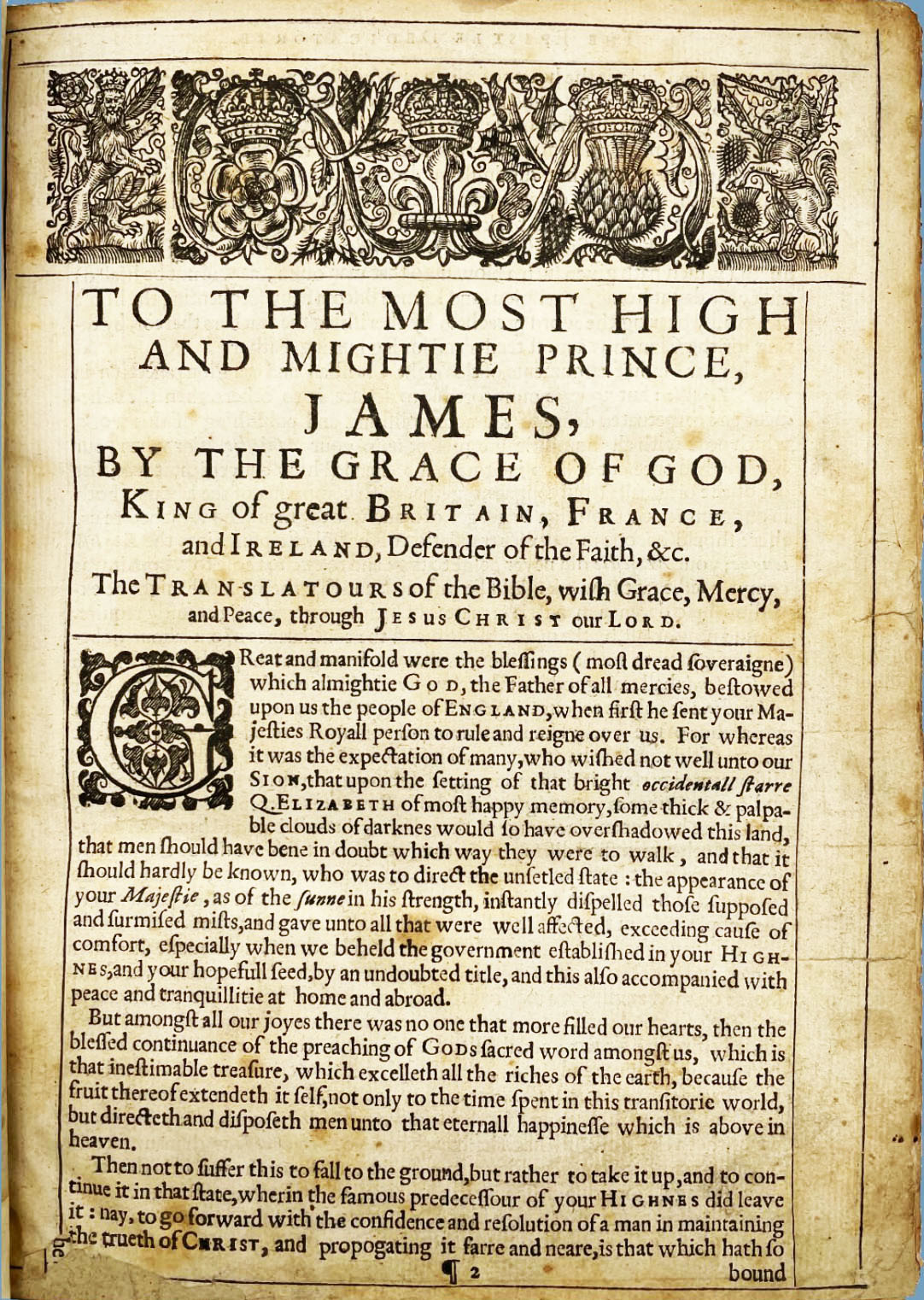
It was a somewhat archaic, but longstanding British tradition to use very pretentious language when addressing royalty, or dignitaries by letter or in memorial documents.
James Stuart Freeman seemed to have a fixation upon providing Hobson’s superiors with English treaty texts that rose above the coarse and simple wording of the final draft. Knowing that the important founding documents of the colony were to come under the critical gaze of British lords and ladies or, perhaps, Queen Victoria herself, Freeman seemed intent upon upgrading the otherwise simplistic, crude, final English text into suitably pretentious language, befitting high stations of the realm. The more beautiful embellishments of language had, earlier, been lopped off the draft texts at the last meeting, when the final draft was severely edited-back and refined for fluid translation into the Maori language. Buick paraphrases Reverend Henry Williams in writing:
The task of translation was necessarily a difficult one, it being essential that there should be a complete avoidance of all expressions of the English for which there was no equivalent in Maori (see The Treaty of Waitangi, by T.L. Buick, pg. 113).
Seemingly, in Freeman’s view, just because it became
essential to couch treaty terminology in pidgin English for translation
purposes, this didn’t mean that it had to so remain when presented
to Her Majesty.*
Whereas uninhibited literary licence could have no ill effect when reporting
mundane events, and one could use flamboyant phrases with impunity, it was
an altogether different matter when identifying the precise text of an internationally
recognised treaty compact.
Freeman, seemingly, couldn’t make that distinction or connection. Perhaps he thought that, if he despatched a treaty text that was too crude or simplistic in its wording, then that, by consequence, might diminished the dignity of Hobson’s office in the estimation of his superiors and reflect badly on Freeman as secretary. A man educated at Eton and Oxford was capable of much better and, moreover, the old school tie demanded as much.
Freeman never showed any inclination towards providing the final draft version for despatch, but sent away a variety of other "composite" versions, in more dignified or highfalutin language. On a couple of occasions Hobson initialled the top corner of a treaty despatch document, which was otherwise fully in Freeman’s handwriting. Other times, Freeman simply signed Hobson’s name for him.
*Footnote: Dr. Phil Parkinson refers to: ‘the formal Royal Style (quite properly employed by Freeman, and not an eccentric case of ‘pride’ as you seem to assert) and sent to Gipps in the despatches of the 5th and 6th February and sent on the 8th February in the Samuel Winter before being forwarded to Normanby on the 19th, now at PRO CO 209/7, 13-15. (Letter to Martin Doutré, 1st November 2004).
To which one must respond that, the injection of a ‘formal Royal Style’ copy into the treaty process could be considered fine, as long as that version is accorded no legal validity and, by it’s very existence, doesn’t nullify the original Tiriti O Waitangi contract. The agreement was set in stone at the assembly on the 6th of February 1840 and can’t be tampered with or affected by Freeman trying to accommodate the perceived delicate sensibilities of royalty. If such catering was considered necessary or traditional, then it was up to Freeman to ensure that, never the twain shall meet and to isolate the contract from the poetry as two separate entities.
Once Hobson had secured a treaty with the Maori chiefs he seemed patently disinterested in what versions Freeman was manufacturing for despatch to Australia, Britain or the United States. As far as Hobson was concerned, there was only one (de facto) treaty contract and it was written fully in the Maori language. English versions were simply drafts or back-translations and no English version was ever intended, by either Hobson’s government or Shortland’s interim government, to be signed by the chiefs.
Bad luck about that horseshoe.
After Lieutenant Governor William Hobson had his stroke and lay paralysed and despondent, trying to recuperate, he was obliged to hand the reins of power to Willoughby Shortland. All of Hobson’s hopes were dashed and his plans were in disarray. He could no longer figure on being present at treaty assemblies around the county where, as the Queen’s duly appointed representative, his presence could wield much influence in inducing the chiefs to sign the treaty. Reverend Richard Davis and his family were looking after Hobson at Waimate and nursing him back to strength. After about the 15th of March 1840 Hobson’s main focus was to attempt to pencil a short note to his wife Eliza in Australia, using his paralysed, but slowly improving, right hand.
At some point at the height of Hobson’s early illness and paralysis down his right side, James Stuart Freeman had placed one of his ad-hoc, composite versions of the treaty in English (Royal Style) under Hobson’s nose. This was, without doubt, while Hobson lay stricken aboard H.M.S. Herald, between the 1st and 4th of March, before Hobson was returned to the Bay of Islands from the Waitemata. Hobson attempted to add a signature using his left hand, but the result was terrible and the signature was the worst Hobson ever executed on any known document.
Freeman had, obviously, written this English language treaty document up for despatch overseas, as none such were ever intended to be sent by the government for use at the treaty signing assemblies. Hobson’s abysmal signature, assuredly, rendered the document worthless and a reject, as, if it had've been sent to either Australia or Britain, the poor signature could have accomplished little else but convince Hobson’s superiors that he was too ill to fulfil the most basic physical demands of office. It’s very doubtful that Hobson would have agreed to let the document be sent anywhere, other than to the nearest waste paper basket.
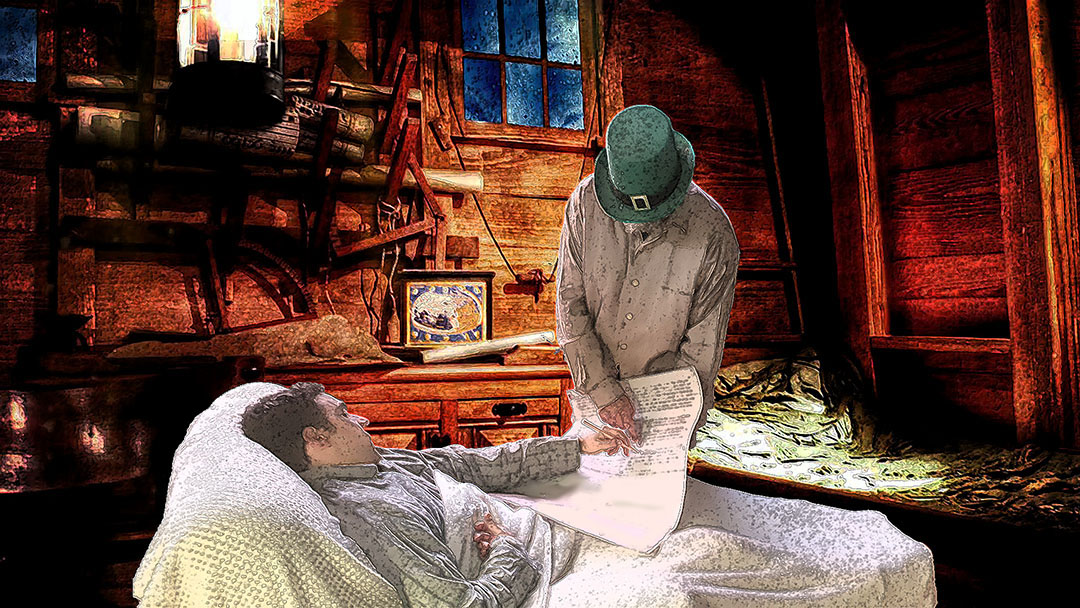
A severely paralysed Hobson attempts a signature with his left hand. He was right-handed. The result was terrible and he executed the most tortured signature of his life, thus ruining the document.

Hobson's left-handed signature at the height of his stroke-induced paralysis.
It seems Freeman couldn't bear to throw away the document he'd put so much effort into creating, so took it with him when he went ashore to the Tamaki treaty assembly on the 4th of March 1840. It was either left near the portage* in Waitemata area and later came into the possession of Captain Gordon Brown or Freeman arranged for it to be sent a courier-messenger overland to Reverend Robert Maunsell. Captain Brown was transporting much printed matter to Reverend Maunsell, located at Waikato Heads, and passed through the Waitemata en-route to Maunsell’s mission station in early March 1840.
This appears to be how Maunsell received the defective English document well before the 11th of April 1840. Inasmuch as Brown’s boat left the Bay of Islands to go to Thames (Waitemata Harbour) simultaneously to H.M.S. Herald leaving the Waitemata to return to the Bay of Islands, it seems that the two vessels were like “ships passing in the night” ... on March 4th or 5th.
The historical record tells us that Freeman sent the reject and worthless, ruined document to Reverend Robert Maunsell at Waikato Heads mission station. Maunsell, in a letter to the Lay Secretary of 30th March 1840 made mention that "the Secretary" (Freeman) had sent the document (or documents) to him. (See R Maunsell to Lay Secretary, 30 March 1840, in ATL-Micro-MS-Coll-04-33 (CMS Archives CN/M v. 12 pp 308-309).
*Footnote: The portage at Tamaki in Auckland was a thin strip of land dividing the East Coast (Pacific Ocean) from the West Coast (Tasman Sea). At this porterage boats, including small cargo vessels, were lugged, hauled or carried (porter is French for to carry) to the waters of the opposite coastal estuaries. The region of Portage Road, Auckland, is where this activity occurred. If Captain Gordon Brown was sailing, via Waitemata, all the way to Reverend Maunsell, then he was obliged to have his boat hauled over the porterage, just like William Cornwallis Symonds did with his vessels about three weeks after Brown.
Freeman was in attendance at the Tamaki treaty assembly, conducted on the 4th of March 1840. Of this meeting, Felton Mathew wrote to his wife:
'Last evening we received a communication from Mr. Williams that the natives had assembled. Accordingly, at 7 this morning, Cooper, myself and Captn Nias sailed down to the place of rendezvous where the ceremony of signing the treaty (as it is called) was soon performed and we have now just returned on board at 3 p.m.'
Captain Nias makes an account of this in his report, mentioning ‘Messrs. Williams and Fairburne’ organising a meeting and his attending it with Felton Mathew and George Cooper. Freeman’s handwriting appears on this Maori treaty signed on the 4th of March showing he was there on the day. There was no need for him to remain on board the H.M.S. Herald, as Hobson was being medically attended to by Dr. Alexander Lane, M.D. & ship’s Surgeon.
Upon the return of Hobson to the Bay of Islands, Willoughby Shortland, Acting Lieutenant Governor, organised a treaty-signing programme in earnest and was choosing experienced emissaries to go to particular Christian missions, along assigned routes, in behalf of the government. The appointees were to work in with C.M.S or Wesleyan missionaries and gain their cooperation as fluent interpreters in the local tongue or dialect, at treaty meetings before the district chiefs.
For this purpose, a series of treaty documents, all in the Maori language, had been prepared throughout February and most of these had been pre-signed by Hobson prior to his stroke. James Stuart Freeman, who suffered from the disadvantage of being a non-Maori speaker, had painstakingly written up the majority of these large and beautifully executed documents.
However, Freeman's first task when returning to the Bay of Islands, was to write yet another such Maori language document, this one destined to be carried by Deputy-Surveyor General, William Cornwallis Symonds to Reverend Robert Maunsell at Port Waikato. IT DIDN'T ARRIVE IN TIME for Maunsell's 11th of April assembly before 1500 Maori and Maunsell was forced to innovate, using a Printed text of the Maori-language treaty, plus spare, scrap paper he had on-hand for any "overflow signatures" that wouldn't fit on the Maori-language, printed sheet.
Handwriting the big Maori language sheets correctly must have required tremendous concentration and it’s very likely that Freeman worked from a master copy created by Reverend Henry Williams. That selfsame master document is probably the unsigned treaty, presently in the collection of the Catholic Diocese in St. Mary’s Bay, Auckland.
There is no record of how many treaty documents were made, but 7 large Maori-language, handwritten copies and 1 printed copy (attached to Freeman's throwaway scrap paper) became the repositories of about 500 chiefly signatures from around the country. Freeman’s mistaken, orphan, English copy, which, unfortunately found its way to Port Waikato, was used to accommodate overflow signatures that would not fit onto the printed Maori sheet presented by Maunsell on the day.
Whereas the New Zealand grievance-industry activists, their lawyers and in-pocket, social-historians claim there are 9 treaty sheets, the actual tally is: 7 officially produced sheets by the government for the assemblies and 1 "make-do", unofficial, signed treaty composed of 2 permanently attached pieces of paper ... one bearing the solitary authorised text and the other only a repository of overflow signatures ... 8 sheets total.
The instructions to each government appointee were clear. Treaty presentations to the chiefs were to be in the Maori language, using only the official text.
Sir James Henare, the last surviving member of the Council of the Chiefs of Ngapuhi of the Treaty of Waitangi recounted, in 1987, oral history about the Waitangi proceeding’s and later hui discussion: ‘Captain Hobson arrived on the 5th at the Treaty grounds and read the clauses of the Treaty or the articles of the Treaty and suggested to the chiefs that they could have ample time, a week, to consider the Treaty and it was the Maori version that was given to them to consider’ (see Hobson...Governor of New Zealand 1840-1842, by Paul Moon, pp 104-105).
This was amplified again, when Williams wrote: ‘We gave them but one version, explaining clause by clause, showing the advantages to them of being taken under the fostering care of the British Government…’
‘The instruction of Captain Hobson was, “not to allow any one to sign the treaty till he fully understood it;” to which instruction I did most strictly attend. I explained the treaty clause by clause at the signing of the same, and again to all the natives in this part of the island previously to the destruction of Kororareka, on March 11, 1845; I maintained the faith of the treaty and the integrity of the British Government, and that the word of Her Majesty was sacred, and could not be violated. That the natives to whom I explained the treaty understood the nature of the same, there can be no doubt; ...” (Volume II of “The Life of HENRY WILLIAMS, Archdeacon of Waimate,” by Hugh Carleton, published 1877 by Wilson & Horton, Auckland).
Let it be re-emphasised that every treaty copy issued by the government for presentation to the chiefs and earmarked to receive their signatures was written in, and was to be presented in, the Maori language. There were no exceptions to this rule. At early assemblies where European settlers were present, Hobson read the final English draft for the benefit of the settlers. Alternatively, Maori were to receive and consider only the version expressed in their native tongue. This was in keeping with the instructions expressed in Lord Normanby’s Colonial Office, guideline brief, given to Hobson before he left England (over 4200-words in length):
‘All dealings with the natives for their lands must be conducted on the same principles of sincerity, justice and good faith as must govern your transactions with them for the recognition of Her Majesty’s sovereignty in the Islands. Nor is that all: they must not be permitted to enter into any contracts in which they might be ignorant and unintentional authors of injuries to themselves*. You will not, for example, purchase from them any territory the retention of which by them would be essential or highly conducive to their own comfort, safety, or subsistence. The acquisition of land by the Crown for the future settlement of British subjects must be confined to such districts as the natives can alienate without distress or serious inconvenience to themselves. To secure the observance of this - will be one of the first duties of their Official Protector’ (See Lord Normanby’s 1839 Brief to William Hobson, The Treaty of Waitangi, by T.L. Buick, pp. 70-79). Underlining added.
*Footnote: Under this strict criteria, only the Maori language treaty wording was ever earmarked for presentation to, and consideration by, the chiefs. Normanby’s Brief is explicit throughout that the whole venture is to be conducted at a high level of integrity and clearly understood negotiation.
The Mission of William Cornwallis Symonds.
On the 13th of March, Shortland sent a newly made, signed Maori copy, penned by James Stuart Freeman and bearing Shortland’s signature, to Captain William Cornwallis Symonds, formerly an officer in the British Army and son of Sir William Symonds, Surveyor of the British Navy. Captain W.C. Symonds was Deputy-Surveyor of New Zealand and an accomplished linguist in the Maori language, with a vocabulary of 3000 words.
His assignment was to collect signatures at Awhiti, Manukau, assisted by Church Missionary Society catechist, Mr. James Hamlin, considered, by many Maori, to have the best accent and ability to enunciate in the Maori tongue of any speaker to be found amongst the European missionaries. Captain Symonds was to conduct treaty meetings with the chiefs, first at the southern shores of the Manukau Harbour, then, with the assistance of Reverend Robert Maunsell, at the Waikato Heads mission. From there Captain Symonds was to undertake a journey further south to the mission station of Wesleyan missionary, Reverend John Whiteley at Kawhia to collect signatures from chiefs ranging down the coast towards Taranaki.
Unfortunately, ardent opponents to the treaty, like Chief Rewa, influenced by the negativity of Bishop Pompallier, had already coloured the thinking of the chiefs at Manukau when Symonds arrived and none signed after the first hurriedly called meeting conducted by James Hamlin and William Symonds. Another meeting was held on the 20th of March where Paramount Chief Te Wherowhero was present, but the only signatures acquired came from three chiefs of the Ngati Whatua tribe. After two futile meetings and only meagre success William Symonds was obliged to abandon any further attempts at negotiation, for the moment, and make his way, belatedly, to Reverend Robert Maunsell at Waikato Heads. Symonds left Manukau on April 3rd, hauling his boats across the portage, which divides the Manukau from the waters of the Waikato. He then proceeded down the Awaroa River to the Church Mission Station at Waikato Heads, unfortunately arriving there several days too late for Reverend Robert Maunsell’s treaty meeting (see The Treaty of Waitangi, by T.L. Buick, pp 188-189).
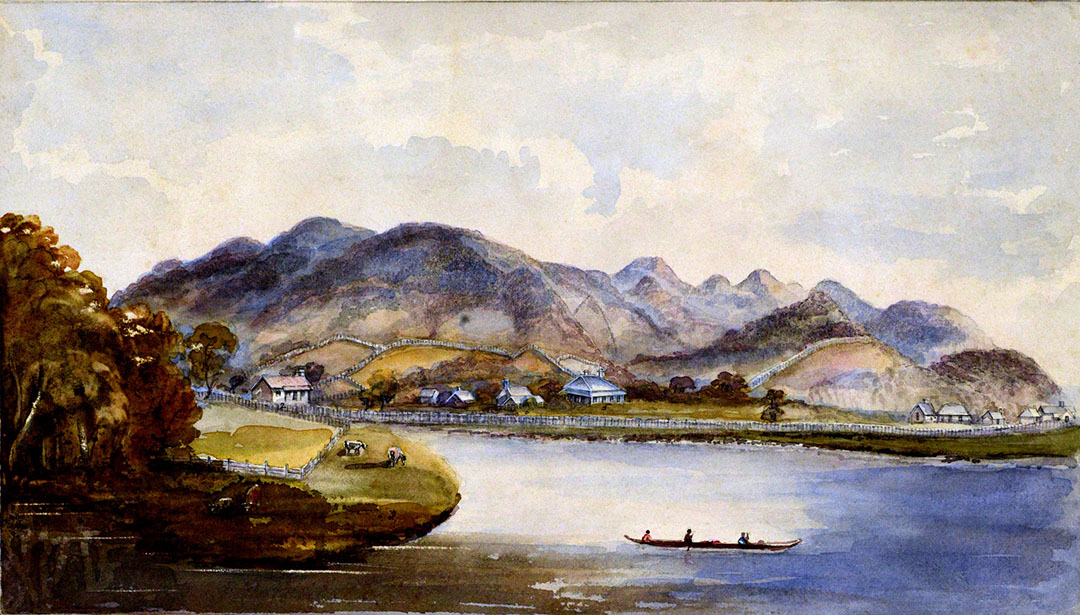
Reverend Maunsell had been obliged to take advantage of an already scheduled business meeting (hui) of the natives in his district to address their assembly concerning the treaty. This meeting was held on April 11th 1840, before a huge Maori assembly (1500 people). Reverend Maunsell was very successful in his endeavours, but within the space of a few days it dawned on the signatories that they had not received blankets, like other chiefs of the north, as tokens of friendship and thanks (koha). Some chiefs were insulted by this oversight and wanted to ‘tear the treaty up’ as a result of the perceived breach in protocol. Reference to this “hui” is mentioned in Te Manihera...The Life and Times of the Pioneer Missionary Robert Maunsell, by Helen Garrett, 1991, pg. 90, wherein it says:
‘Amongst the missionaries, four were appointed to collect signatures. One of the four was Maunsell*, who was sent a copy of the Treaty* and was responsible for getting signatures of the Waikato chiefs. He took advantage of a business meeting of the natives in his district to produce the Treaty’.
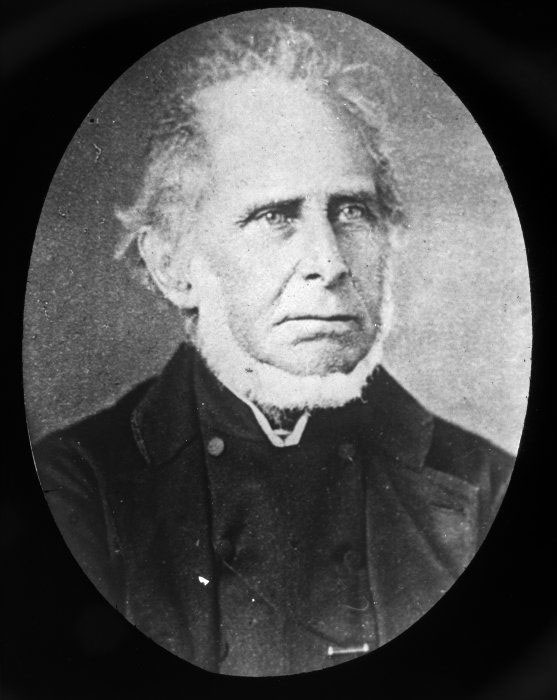
Reverend Robert Maunsell (circa 1880) aged about 70-years old. He was 30-years old when he convened his Port Waikato treaty assembly before 1500 Maori.
*Footnote: It’s important to remember that Maunsell was only ever sent one official treaty document by the government (and that it was in the Maori language), despatched with William C. Symonds on the 13th of March 1840 and originating from Willoughby Shortland, Acting Lieutenant-Governor. It didn’t arrive in time.
Thankfully, before the situation with the slighted chiefs at Waikato Heads got too far out of hand for Reverend Maunsell, Captain W.C. Symonds arrived at the mission. He’d brought Maunsell’s official treaty document too late for it to be of any use. Symonds had a few blankets with him and these were distributed, with a promise that more were arriving. The formerly insulted chiefs were appeased at the gesture and goodwill returned. Maunsell had been awaiting the arrival of Symonds, ‘with no small anxiety’ (see The Treaty of Waitangi by T.L. Buick, pp 188-189).
Maunsell, in lieu of having received the official treaty document, had innovated to take advantage of the hui business meeting on the 11th of April, at which chiefs from far and wide were assembled. For his presentation on the day he had a Church Mission Society printed Maori version of the Treaty of Waitangi, undoubtedly sent down by Colenso from Paihia, via Captain Brown on the 4th of March 1840. He also had a beautifully hand written, but unauthorised or defective, English copy. This English copy was one of the ‘Formal Royal Style’ versions for overseas despatch, penned by James Stuart Freeman, using rejected Articles from Busby’s rough notes of the 3rd of February 1840 and one of two choices of early Preambles. How, exactly, Maunsell had acquired this copy remains a mystery, but we know for certain that it was not sent to him by the government for use in his meeting.
True to his instructions from Hobson, Maunsell would have conducted his entire presentation in the Maori language, using only the Maori text. Nevertheless, the big, impressive looking piece of paper in English had a large clear space at the bottom, which could serve the purpose of accommodating additional signatures when there was no further room left on the Church Mission Society (Maori language) printed copy.
Like at all other centres around New Zealand, the standard Maori text is what was presented to the chiefs and 1500 of their tribes-people at Waikato Heads. The first chiefs coming forward signed the C.M.S. Mission printed sheet, but quickly ran out of room. Reverend Maunsell’s signature can be seen on the upper right hand side of the handwritten section, where it says, ‘signed in my presence, R. Maunsell’. All handwriting on this sheet is that of Reverend Robert Maunsell. Captain Gordon Brown brought this copy to Maunsell in mid or late March. Colenso issued several hundred printed items to Captain Brown on the 4th of March at Paihia, which were destined for Maunsell at Port Waikato*.
*Footnote: According to the Day & Waste book of C.M.S. printer, William Colenso, on the 4th of March 1840 he “issued” a large batch of materials for Reverend Robert Maunsell of the Waikato Heads mission. Colenso’s record states that he printed 500 Prayer [books], 300 Primers, 200 Kupu Ui and 3qu (3 sheets for covers). These were ‘issued’ to Gordon Brown to be taken to Maunsell on Brown’s boat, going by way of Thames. Colenso’s note stated: ‘Issued to R. Maunsell, for Waikato and Manukau’ (see Colenso’s Day and Waste Book, 1840, Auckland Institute and Museum Library).
On the following page is the C.M.S printed Treaty of Waitangi text copy, used by Reverend Robert Maunsell and his assistant Benjamin Yate Ashwell on April 11th 1840:
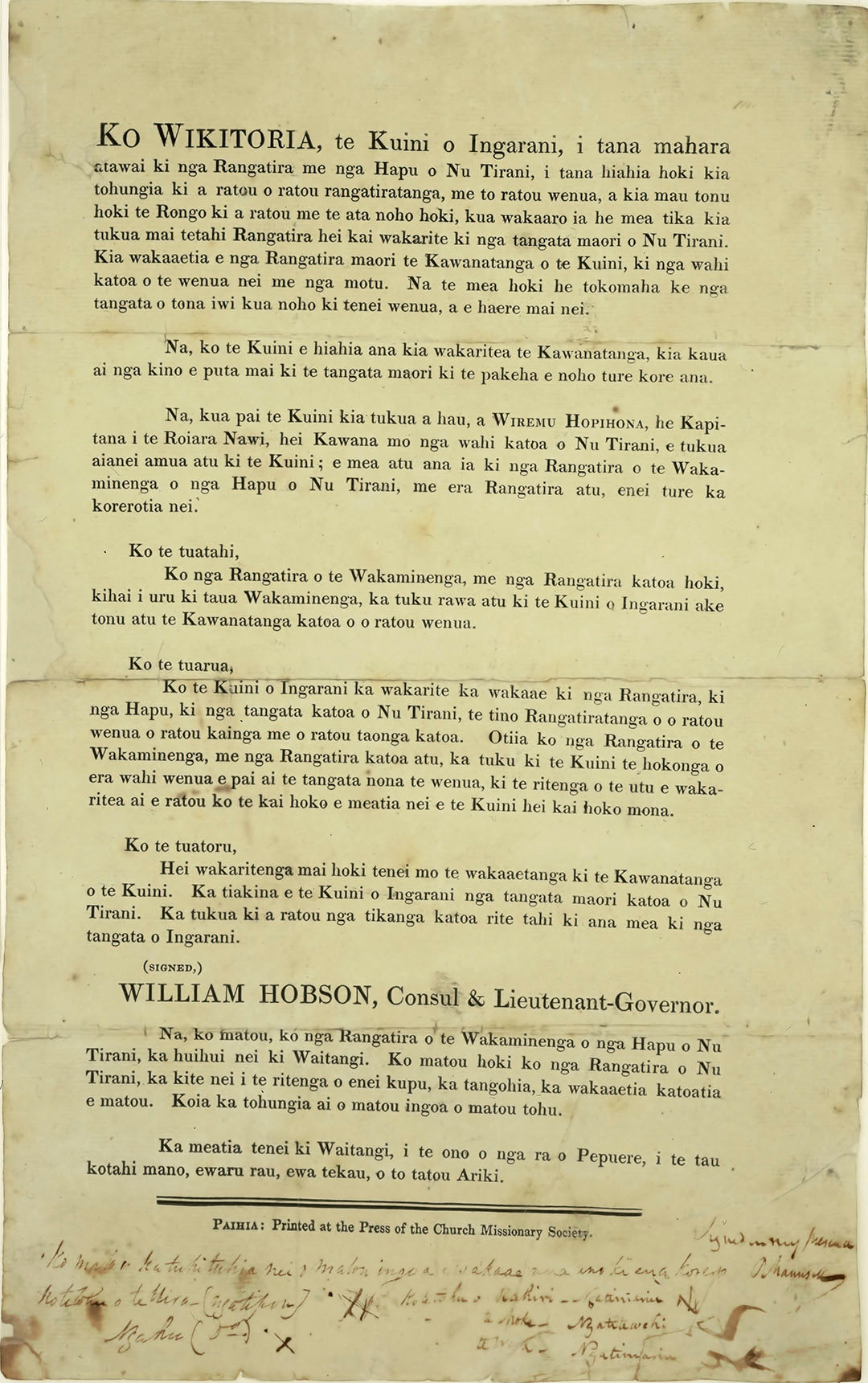
Like at all other centres around New Zealand, this standard Maori text is what was presented to the chiefs and 1500 of their tribes-people at Waikato Heads. The first chiefs coming forward signed this sheet, but quickly ran out of room. Reverend Maunsell's signature can be seen on the upper right hand side of the handwritten section, where it says, 'signed in my presence, R. Maunsell'. All handwriting on this sheet is that of Reverend Robert Maunsell. Captain Gordon Brown brought this copy to Maunsell in mid or late March. Colenso issued several hundred printed items to Captain Brown on the 4th of March at Paihia, which were destined for Maunsell at Port Waikato.
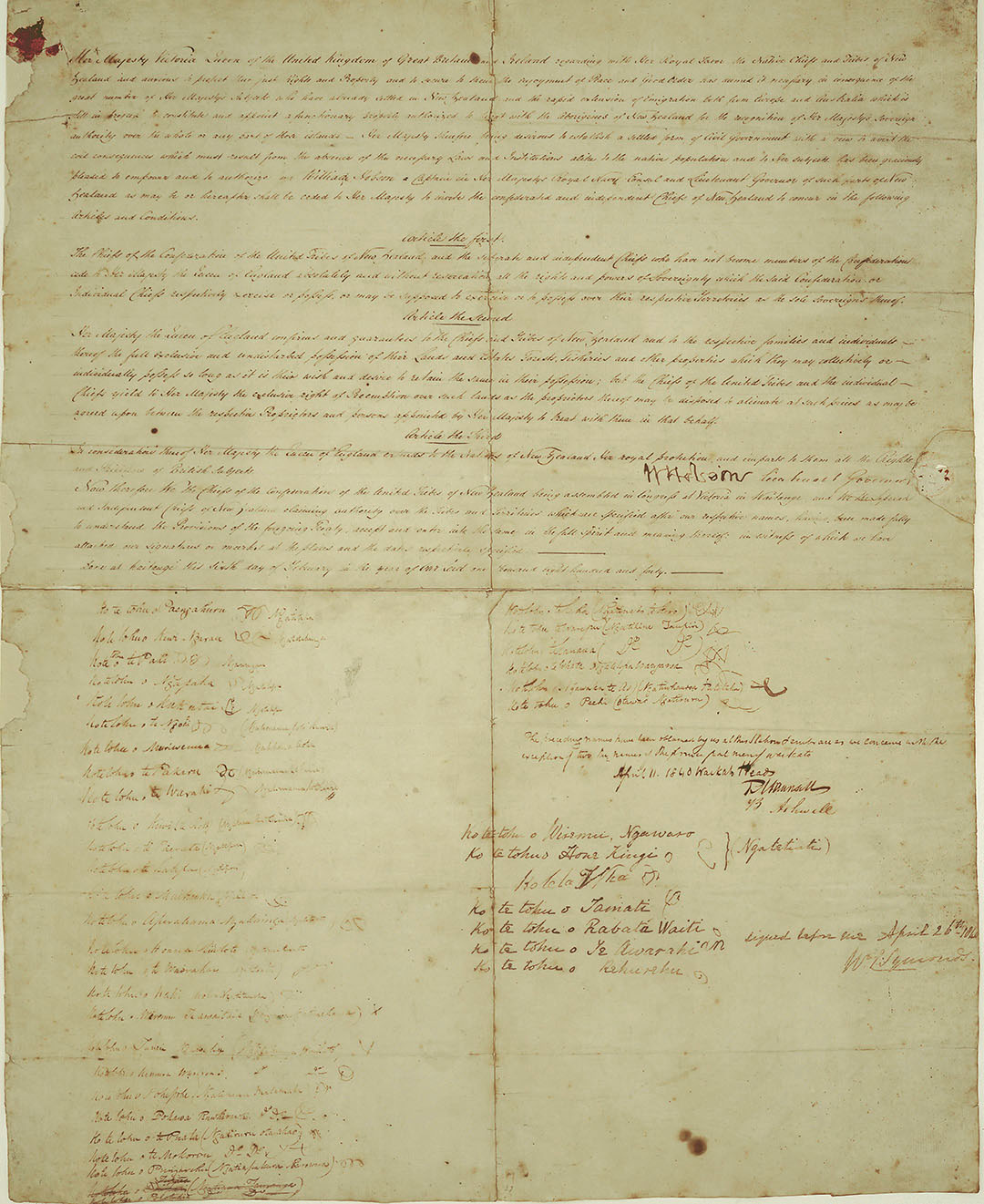
Captain Gordon Brown was passing through the Waitemata region in early March with C.M.S Mission printed supplies for Maunsell. It’s plausible to assume that James Stuart Freeman left this reject English copy at Tamaki on the 4th of March 1840 and that it came into Captain Brown’s possession when he took his boat over the Tamaki porterage while en route to Maunsell. This is one of Freeman’s ‘Royal Style’ versions, of which he produced several variations to send overseas during this period. Unlike the printed Maori copy that Maunsell based his presentation of the 11th of April 1840 on, this big piece of paper, at least, had sufficient room at the bottom to receive the overflow of signatures that wouldn’t fit on the printed Maori sheet. On the day, after the first five chiefs had signed the printed Maori copy, the next thirty-two signatures overflowed onto this one.
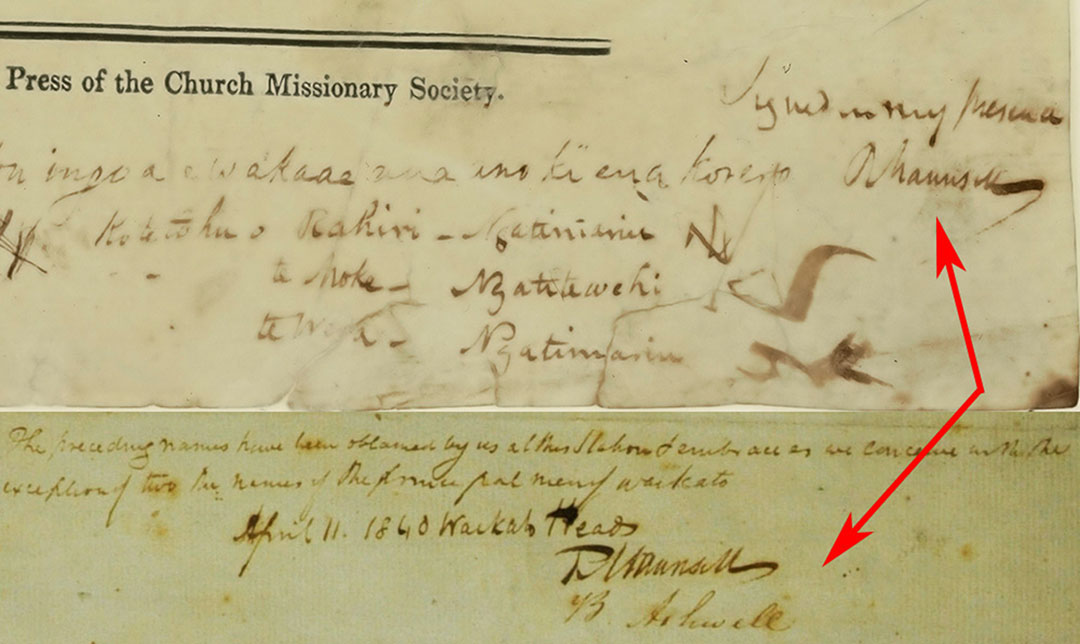
‘THE ENGLISH TREATY AS SIGNED’
The situation of some overflow signatures coming onto the orphan, out-of-place,
English treaty sheet has led to a legal fiction called “The English
Treaty As Signed”. The fact that some overflow Maori signatures
ended up on this defective English version somehow legitimises its elevation
to the status of the only true treaty wording. Grievance industry advocates
cannot manipulate Te Tiriti O Waitangi, so seek to supplant it with “The
English Treaty As Signed”, which is hugely exploitable. With this
English version they can hold the country to ransom.
Recently a friend wrote a letter to Prime Minister Helen Clark, asking why
the true Treaty of Waitangi wording was not used in the implementation of
Acts of Parliament and legislation. The Prime Minister funnelled Mike’s
enquiry to the Hon. Parekura Horomia, who answered the question in the following,
typical and expected manner.

The Hon. Parekura Horomia refers to the ‘considerable scholarly
debate’ that has ensued since 1989 about the Littlewood Treaty document.
He then dismisses it as a ‘back-translation of the Maori version and
goes on to extol the virtues of the ‘only signed English version’.
In response to the Hon. Parekura Horomia:
• There has been virtually no scholarly debate about the merits of the Littlewood Treaty. At least, the public of New Zealand aren’t aware of the subject being broached and dissected in any open forum. To the contrary, our scholars have avoided discussing the subject in public, altogether, for over a decade.
• Yes, thirty-two signatures spilled over onto the unauthorised English document that was never sent by the government for use at Port Waikato in the 11th of April 1840 meeting. The first five chiefs coming forward signed the printed Maori copy, which had been presented by Reverend Maunsell. An additional seven signatures ended up on the orphan English sheet after W.C. Symonds’ third meeting at Manukau. He’d already arranged to have the only government issued document forwarded on to Reverend Whiteley. Symonds, like Maunsell, used the authorised text, printed Maori version for his assembly on the 26th of April 1840.
• You state, more or less correctly that, ‘The Maori version is legitimate in its own right and does not require a ‘final’ English version for its validity or interpretation’. There is only one Treaty of Waitangi-Tiriti O Waitangi compact and it’s in the Maori language. In a fair and just world of checks and balances, however, the final English draft must be consulted if there is confusion, deliberate or otherwise, in interpreting the meaning of the Treaty.
• Do you know that ‘ki nga Rangatira ki nga hapu-KI NGA TANGATA KATOA O NU TIRANI’… means… ‘to the chiefs & tribes AND TO ALL THE PEOPLE OF NEW ZEALAND’…? We would consider it a gesture of enduring friendship if you would desist from further opposing Ngati Wikitoria (the tribe of Queen Victoria) regaining their equal rights and protections, as guaranteed under Article II of Te Tiriti O Waitangi!
From about 20-years after the signing of the treaty, until the present day, our legislators have never properly addressed and rectified this minor procedural faux-pas initiated by Maunsell or the perceived legal implications that might be construed to have arisen because of it. Maunsell’s naïve and innocent use of the defective English composite draft, as a repository for overflow signatures, is easy to identify in a documented or paper trail sense. One can easily see that he conducted his meeting correctly, but that a miscellaneous piece of paper was pressed into service when the contract document had no further room to accommodate signatures. We might turn it all around, just to be mischievous, and ask:
What if that miscellaneous piece of paper, the content of which no chief had heard or understood at the meeting, had've been, say, Captain Gordon Brown’s bill to the mission for the recent shipment of supplies… would the chiefs then be liable, as guarantors, for payment? What if it said that sovereignty was being ceded to France? What if it said that the chiefs agreed to be slaves in the cotton fields of Louisiana? What if it said the chiefs had to pay the parliamentary booze bill at Bellamy’s forevermore?
The signatures of the chiefs were volunteered in good faith, in response to what they had heard and understood, which was Te Tiriti O Waitangi text in Maori. The true, accompanying Maori document, containing the pertinent contract wording presented by Maunsell, was on the table and was in the process of being signed. It would have continued to receive all the signatures of all the chiefs had there been space available. When there was no more room to accommodate additional signatures, the overflow signatures spilled over onto the second sheet, the content of which was irrelevant, inasmuch as it was in a foreign tongue and had never been presented. It was just a piece of paper, pressed into service and acting as a physical extension to the printed Maori Tiriti O Waitangi sheet.
Hobson had stated that there was only one de facto treaty and that it was a document in the Maori language.
Most assuredly, Robert Maunsell stood before the 1500 Maori, gathered in to Port Waikato on the 11th of April 1840, and read them the correct, singularly Maori text, lifted directly from the official C.M.S. Mission printed sheet in his possession, which he later signed. The assembled Maori at Waikato Heads heard exactly what every other assembly heard, which was the standard Maori text for consideration and discussion. The same holds true for all three Treaty assemblies conducted at Manukau by Symonds, the last one of which involved the usage of Maunsell’s make-do treaty documents.
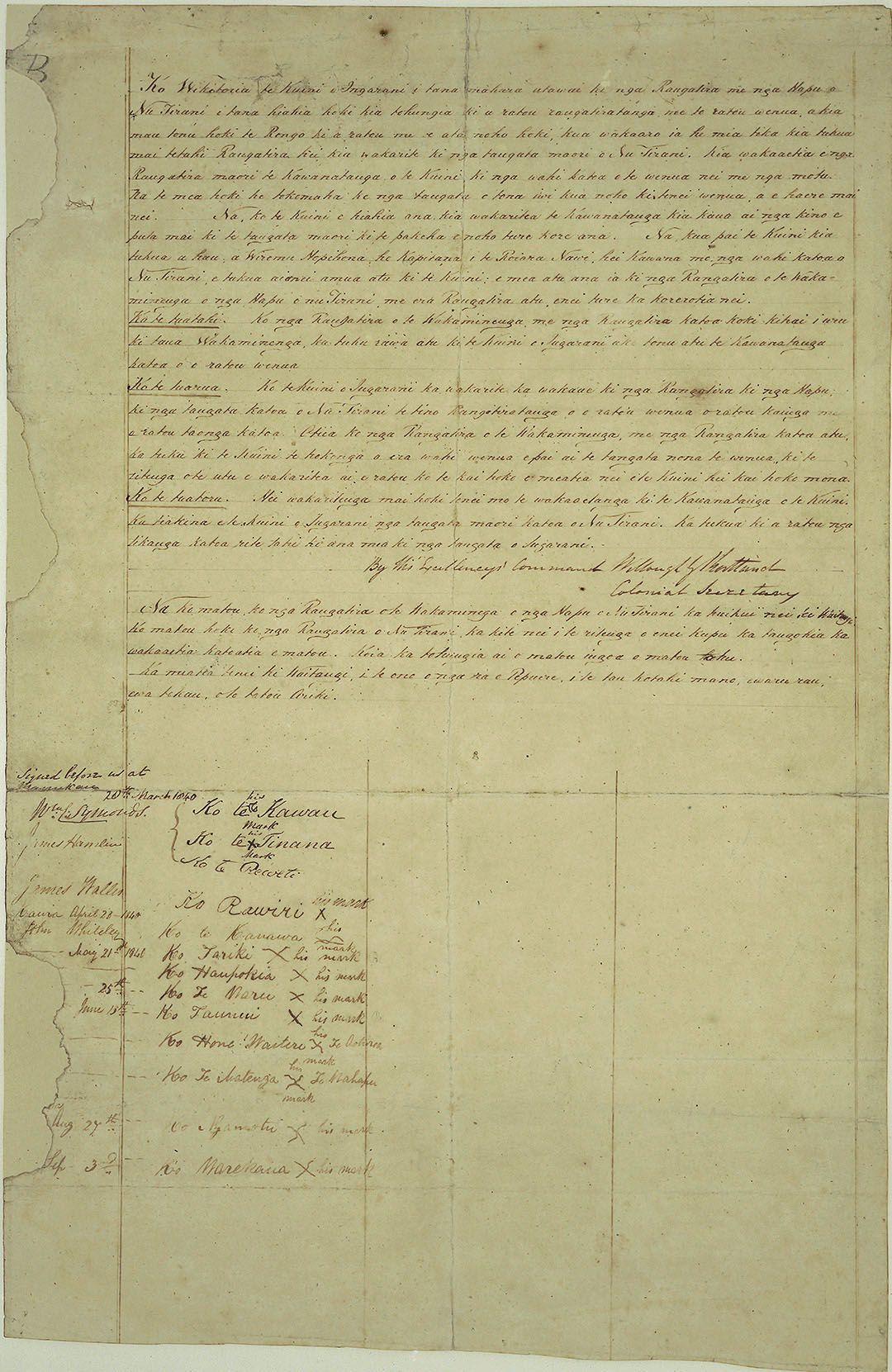
THIS IS THE ONLY TREATY DOCUMENT EVER ISSUED BY THE GOVERNMENT FOR USE IN THE TREATY PRESENTATION AND SIGNING ASSEMBLIES AT MANUKAU, PORT WAIKATO AND KAWHIA. NOTE: IT IS IN THE MAORI LANGUAGE!
The foregoing is the ONLY official treaty document (handwritten by James Stuart Freeman in Maori) ever issued by the colonial government for use in the signing ceremonies at Manukau, Waikato Heads and Kawhia. These regions and districts, nominated for treaty discussion and signing gatherings before the chiefs, constituted the mission of Captain William Cornwallis Symonds, Government appointee for treaty negotiations and Deputy-Surveyor of New Zealand. W.C. Symonds’ assignment, issued by Acting Lieutenant Governor, Willoughby Shortland, was to go first to Manukau and receive signatures from the chiefs there with the assistance of Missionary James Hamlin of the C.M.S. Station. He was next to go to Waikato Heads and conduct a treaty meeting, with the assistance of Reverend Robert Maunsell and Benjamin Yate Ashwell. After completion of work at and around the Waikato Heads district, Symonds was to carry this official document, bearing all signatures gathered en route, to Reverend John Whiteley and his assistant, James Wallis and conduct a series of meetings there, as well as, further south in Taranaki.
Maunsell wrote to Hobson: ‘and I have already forwarded on to Messrs Wallis and Whiteley the document left with me by Captain Symonds in order that they may obtain as many more names as they deem expedient’ (see Robert Maunsell LL.D. A New Zealand Pioneer, His life and Times, by Henry E.R.L Wily, 1938, pp 68-69).
At all three meetings at Manukau the chiefs heard each presentation in their native tongue.
Maunsell was known to be amongst the most accomplished Maori speakers, to be found in the ranks of the missionaries in New Zealand. At the time of this meeting at Port Waikato he was engaged in translating the Old Testament of the Bible into Maori. Earlier, in order to learn the language, he would sit in discussion circles with Maori and have long conversations on general topics. After becoming very fluent he made an offer: If anyone in the circle heard him use a word in error or out of context, then they would receive a wad of tobacco, once they’d proven he was, in fact, incorrect in his use or understanding of a word. Maunsell, apparently, went through a lot of tobacco but, in the end, graduated to becoming a formidable linguist in Maori.
Historian Ruth Ross wrote in 1972:
‘James Edward FitzGerald remarked in a debate on the Treaty of Waitangi in the House of Representatives in 1865: ‘if this document was signed in the Maori tongue, whatever the English translation might be had nothing to do with the question.’ He went on to point out: ‘Governor Hobson might have wished the Maoris to sign one thing, and they might have signed something totally different. Were they bound by what they signed or by what Captain Hobson meant them to sign?’
In a fair and just New Zealand, where no-one was vying for advantage over anyone else, the circumstances of what happened at Port Waikato on the 11th of April or at Manukau on the 26th of April 1840, wouldn’t warrant serious comment in any legal sense. It’s crystal clear what happened and the minor glitch of an unauthorised document being pressed into service to accommodate overflow signatures cannot possibly render the Maori Tiriti O Waitangi text null and void as we’re led to believe.
The logic that the grievance industry advocates bludgeon us into accepting
without question is that the signatures of over 500 chiefs, affixed to Maori
language treaty documents, were eclipsed and made worthless when Maunsell
innovated, without government sanction, to have a “make-do” treaty
document available for his meeting... despite the fact that he presented
the Maori Tiriti O Waitangi text to the chiefs, who then came forward to
sign, solely on the basis of what they had just heard.
Somehow, according to the logic we’re supposed to blindly accept, all
European settler rights were immediately extinguished by Maunsell’s
faux pas. Moreover the entire mission of Hobson, unbeknown to him as he
recuperated miles away at the Bay of Islands, suddenly became an abject
failure.
Instead of legally dismissing this minor procedural glitch with the shrug that it deserves, it’s allowed to be a bastion and rallying point for a pack of voracious hyenas, intent upon gorging themselves insatiably on a succulent carcass called New Zealand.
Let’s digress for a moment to consider the new, legal predicament, foisted on us by malevolent legislators.